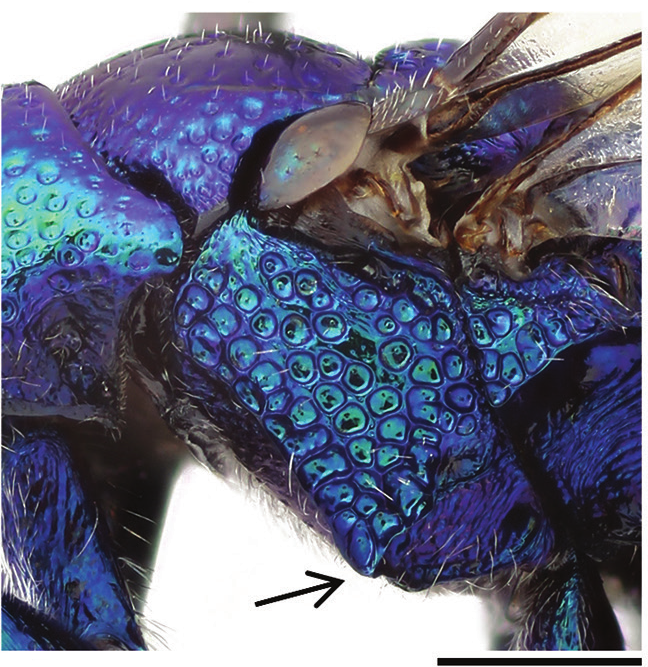Elampus constrictus
A relatively rare species found in sandy areas. The hosts are Crabronidae in the genus Mimesa. The species is frequently visiting flowers. E. constrictus can be separated from closely related species by the apical truncation of T3, which is shaped like a boomerang.
- Innhold
- Diagnosis
- Distribution
- Biology
Diagnosis
Figure 42
Mesopleuron, lateral view (arrow indicating junction of omaulus and scrobal carina): E. constrictus ♀. Scale 0.5 mm.
Figure 45
T3, postero-dorsal view: E. constrictus ♀. Scale 0.5 mm.
Length 4–7 mm.
The species differs from E. panzeri and E. foveatus by the structure of the apical truncation of T3, which has pointed margins ventrally and resembles a sickle or a boomerang in shape (Fig. 45). Sometimes the apical truncation is very narrow, similar to that of Philoctetes truncatus. The lateral margins of T3 are shallowly concave anterior to the apical truncation. As opposed to E. panzeri and E. foveatus, the scrobal carina reaches the angle of the omaulus (Fig. 42). Both sexes are usually bicoloured with a blue or greenish head and mesosoma, and a reddish metasoma. Entirely greenish or blue specimens are found occasionally.
Distribution
Denmark, Estonia, Finland, Norway, Sweden. Relatively rare.
Trans-Palearctic: widely distributed in the Palearctic Region, from Europe to China (Rosa et al. 2014).
Be aware that the records present in the GBIF map may be misleading for some countries due to unrevised data sets or missing information.
GBIF Taxon: Elampus constrictus (Förster, nec auctt.)Biology
Habitat: sparsely vegetated sandy areas, heaths. Adults occasionally visit
flowers of Apiaceae and Rosaceae (Linsenmaier 1997, Rosa 2004).
Flight period: May to July.
Host: Mimesa bicolor (Jurine), M. equestris (Fabricius) and M. lutaria (Fabricius) (Crabronidae) (Benno 1950, Lomholdt 1975).


